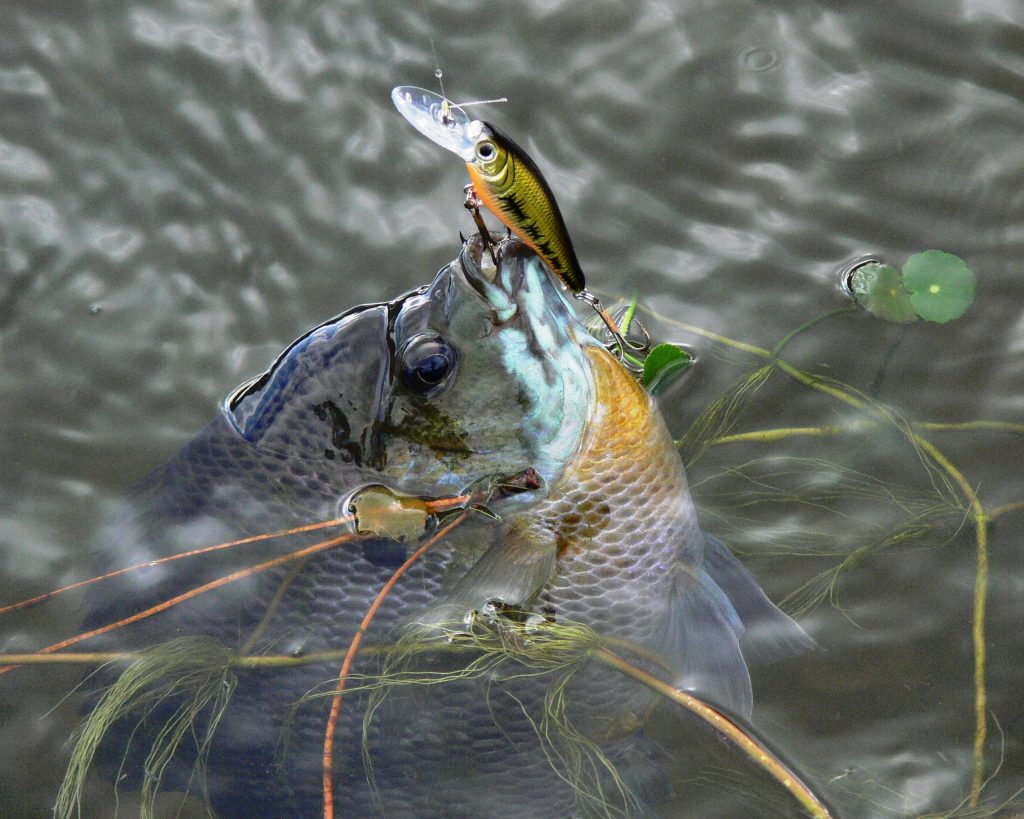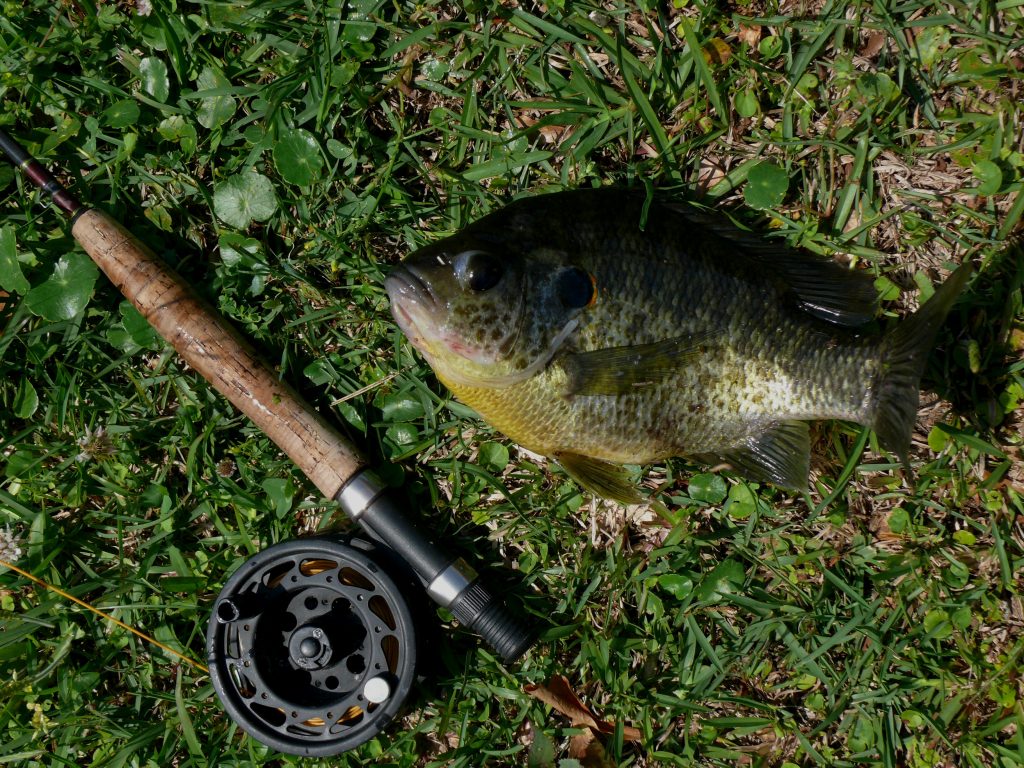Early Spring Bream Fishing
The spring sun is starting to get some weight behind it, and the warmth of the breeze feels quite nice on this pleasant afternoon. But as nice as the sun and breeze feel, neither of them compares to the feel of the rod bending over in my hand and the strong thumps of a big spring bream tail as it fights for freedom.
I had cast my tiny crankbait as far as I could ahead of me where the pond bottom dropped off from the two-foot shallows where bream would be bedding and working hard in a month or so. I wanted my lure to move through the deeper water, and from the fight I had on my hands, it looked like what I wanted to happen worked pretty well.
Finally, my little rod wore the strong fish down, and there at my feet was a dark, humpy-headed pre-spawn bluegill which didn’t like being removed from his early spring water much at all. This round fish was brightly colored, and it was a most pleasing sight to see on this early spring morning.

The biggest bream are willing to crash bass crankbaits. Photo by Ed Mashburn.
Where They Are In Early Spring
From the big northern lakes of Alabama, Guntersville and Wheeler, down to the massive Mobile Delta and everywhere in between, some world-class bream can be found. Both bluegills and shellcrackers make Alabama home, and anglers are never far from a potentially great, early spring bream fishing spot.
Especially the myriad of small ponds which dot the Alabama landscape are great early spring locations for bream fishing. In fact, these smaller, shallower ponds often warm up quicker than the bigger waters, so anglers can find the bream more eager to bite in the ponds and small reservoirs.
“Anglers need to look for color changes in the water whether they’re fishing small ponds or big reservoirs.”
Even in southernmost Alabama where cool weather is a thing of short duration, the biggest bream are not yet on the beds. They’re beginning to think about going up in shallow water and doing the spawning thing, but they are waiting until the water gets warm enough and stays warm enough for an extended period of time.
In March, the bream are usually actively working drop-offs and ledges that are deep enough to provide cover, protection, and good feeding yet are close to the spawning grounds that the big bream will be moving into shortly.
Anglers need to look for color changes in the water whether they’re fishing small ponds or big reservoirs. These color changes often represent changes in depth. The darker water which usually indicates deeper water is where we’ll want to concentrate our efforts.
When Do Bream Start Biting
At this point, bream are getting ready for the stresses of spawning. Especially for the bigger females who produce massive amounts of eggs in the long spawning season. March is a time that these fish must feed heavily and build up as much energy reserves as possible.
In early spring, bream will feed heavily on underwater insects, and they will also take small fish which get too close. Any kind of lure that looks like something edible will be taken by big, hungry bream in March.
Although the biggest bream won’t chase lures or bait far or fast, they will take the right size offering that is presented close to them.
How To Rig For Them
In March, anglers will want to concentrate their efforts on sub-service lures. Popping bugs and other topwater bream baits won’t be as effective now as they will be later in the season as the water warms.
March is prime ultra-light spinning tackle season. Anglers who use a six-foot, very lightweight rod with a matching lightweight reel and 4 to 6 lb. line will be in great shape for some early bream fishing. This very lightweight rod and reel allows some long casts with very small lures and bait.
Anglers might want to think about using a high-visibility line for early spring fishing. The high-vis line allows anglers to see the line move as it sinks and when a bream bites in early spring, it is often very subtle- not the “dash and smash” strikes that the bream will provide later in the spring. Early spring bream anglers need to be able to see the line twitch when a big bream sneaks up on a lure and takes a small bite.
Fly rod anglers are not left out in March when it comes to fishing for big bream.
Dark, sinking flies, which resemble insects or small minnows can be very effective. Make a long cast over potentially good water and let the fly sink. Watch the end of the fly line closely. When it twitches or moves the slightest little bit, set the hook.

A fly rod and some big shell crackers- a whole lot of fun. Photo by Ed Mashburn.
What Baits/Lures to Use
March is prime time for Alabama anglers to use small crankbaits worked slowly along deep water ledges and drop-offs. The color of the lure is not very important, but retrieve and action is. There are several scaled-down crankbaits which are designed for use on bream, and big bream have a hard time resisting a wiggling crankbait brought in their neighborhood.
These mini-crankbaits need to be retrieved just fast enough to get them to the depth you want and no faster. A slow side to side wobble is the best action, and a pause to let the little crankbait slowly rise in the water is a good technique, too. The big bream often take the crankbait as it slowly floats up.
Very small spinners like Rooster-tails and Beetle spins in the smallest sizes and in dark colors can be very effective on early spring bream. Again, these little lures should be retrieved just fast enough to make the spinner flash and provide a little vibration in the water. Don’t expect a massive strike from the bigger bream. The line will just get heavy, and then a fight will begin.
“For live bait anglers, this is a good time to put on a nice fat worm and cast it into the transition water where the biggest bream are holding.”
A deadly technique for March big bream fishing in Alabama is to use a very light jig-head, say 1/8 to 1/16 oz., with a short soft plastic body. Either a small grub or my favorite, a two-inch long plastic worm, will often work very well when fished slowly along the bottom.
The only real problem with fishing these little ultra-light lures for early spring bream is that very often, some big slab crappie and some quite large bass will often take these lures intended for bream. Especially in the bigger reservoirs, bream anglers may have to sort through a lot of big slab crappie when fishing for early spring bream. Most anglers will figure out how to deal with this sort of problem when it arises.
For live bait anglers, this is a good time to put on a nice fat worm and cast it into the transition water where the biggest bream are holding. Either no weight at all or a very light 1/24 oz. split shot will work best. We’ll need to be careful dropping live worms near deeper-water holding spots in early spring. Some of the very biggest shellcracker bream love to hold tight to this deep water, and they love to eat worms on the bottom. Some of these big redears will test an ultra-light rig pretty hard.
For a very interesting time, if a live bait angler can find some very small crawfish, say two-inches long or smaller, these little mudbugs are absolutely deadly on big pre-spawn bream. The little crawfish can be hard to find. Look in spring creeks and in shallow water ponds to find them. But if a bucket of little mudbugs can be located, some very fast, early-spring fishing for some very big bream is a real possibility.
So, March Out And Find Some
Of course, spring fishing of all kinds is very dependent on the weather, and this big bream fishing is no exception.
If we have an easy winter and the spring breaks early, the water may warm enough in middle and late March for the bream to actually start moving onto the beds. But don’t count on this happening every year.
A strong late-winter cold front can keep the big bream in deeper water until true spring arrives and gets the water up toward the magic 70-degree mark which triggers most of the bream spawning activity.
But regardless of the March weather conditions, anglers can find some very good fishing for very big bream. Just keep casting and looking until the right shoreline and the right drop-off is found, and then have some fun.
Full Disclosure: This post may include affiliate links. There’s no extra charge to our readers for using these.
